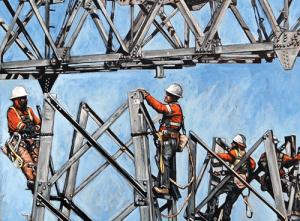Guidehouse
Chris Rogers is a partner at Guidehouse responsible for the overall general management of Guidehouse's West U.S. energy practice, ensuring his teams are bringing the best of Guidehouse to our clientele and delivering with delight. An accomplished leader with twenty-five years-plus in management and technology consulting across multiple industries, for the past seven years, Chris has focused on solving the most complex challenges and opportunities brought by the triple transformation afoot within the energy industry: business and regulatory model change, the clean energy transition, and industrial revolution 4.0.
Raquel Malmberg is a partner in Guidehouse's U.S. State and Local Government Advisory Practice and leads the Community Building and Investment team. She has twenty years of experience working for and with government agencies to improve their operations and implement strategies and recommendations to fulfill their missions. Raquel works with clients around the country to design and implement federally funded projects. She works to ensure clients are maximizing their federal dollars and developing strategies to meet the unique needs of their constituents. Raquel supports state and local governments with project development, financial management and tracking, monitoring and compliance, and closeout. Prior to joining Guidehouse, Raquel worked for more than nine years for the City of New York.
Britt Harter is a partner at Guidehouse. He is the leader of Sustainability consulting for North America, covering both the public and private sector. Britt has twenty-plus years of experience on sustainability topics, accelerating organizations on their sustainability journey. He has created recognized ESG and sustainability strategies for Fortune 500 firms across sectors including energy, consumer goods, financial services, materials, and technology as well as major public sector entities like the City of Los Angeles.
Ed Batalla is a director in Guidehouse's Energy, Sustainability, and Infrastructure segment, delivering full life cycle solutions to transform energy markets, system operations and infrastructure, assets, and technologies for a more sustainable, resilient, and secure energy system. Ed has a strong track record that spans more than thirty years in the electric utility and energy industry environments and associated technologies. Ed assists energy, utility, and governmental clients in crafting their smart grid and energy system transformation strategy, vision, and mission, leveraging the integration of new technologies to transform the business and organization, as well as in developing their energy vision.
Robyn Link is a director within the Energy, Sustainability, and Infrastructure segment, where she leads the commercial and industrial solutions consulting group. She brings more than seventeen years of experience successfully driving, accelerating, and delivering organic growth for both established and early-stage businesses within the energy sector. Robyn has partnered with eighty-plus utility companies (IOUs, Co-ops, and Municipals) in North America to create and deliver new, transformational load management, and customer engagement solutions that drive results and resolve significant business challenges for utilities.
Graham Dickson is a director at Guidehouse, leading the business strategy and transformation team within the Energy, Sustainability, and Infrastructure practice. Graham has developed and executed customer strategies impacting more than fifty million energy customers in the U.S. and abroad, with a focus on building innovative business models and designing operating models to navigate the energy transition for utilities and technology companies.
Nicole Wobus is a director at Guidehouse with more than twenty years of experience managing projects and programs that address environmental policy, planning and markets, with areas of focus including land use, energy efficiency, and renewable energy. She focuses on climate action, sustainability, and resilience-related planning for local governments and other organizations, as well as clean energy program design, evaluation, policy, and market studies for a range of clients nationwide. Her work helps guide resource and policy decisions aimed at tackling climate change and building more sustainable, resilient communities and operations.
Having worked as Long-Range Planning and Policy Manager for Boulder County for four years, Nicole is experienced in managing policy and regulatory updates involving stakeholder collaboration and engagement. She is an American Institute of Certified Planners certified planner with a master's degree in Urban and Environmental Policy and Planning, and has a broad background in sustainability and green building practices.
Shaun Fernando is a partner at Guidehouse, leading strategy and economics consulting services, working with governments, utilities, transportation agencies, and the private sector on a range of strategic and public policy initiatives, specifically in the areas of economic development and industrial policy, climate change and net-zero decarbonization, and broadband and connected communities. Shaun sits on the eight-member Economic Roundtable for the Southern California Association of Governments, the federally mandated planning organization for the region. Shaun is also a Fellow at the Atlantic Council, advancing the council's agenda on the net-zero economy and social capital.
Danielle Vitoff is a director within Guidehouse's Energy, Sustainability, and Infrastructure practice. She focuses on strategic engagement around decarbonization, resilience, and sustainability for governments, corporations, and utilities. Danielle is a skilled project manager who has successfully led clients in exploration and public engagement to develop defensible sustainability strategies that support multifaceted business goals. Notable engagements include the San Antonio Climate Action and Adaptation Plan, leading the development of the American Gas Foundation resilience study, decarbonization roadmaps for multiple natural gas utilities, managing the California Sustainability Alliance, and the development of a science-based target for The Coca-Cola Company.
Lisa Frantzis is a partner in Guidehouse's Energy, Sustainability, and Infrastructure segment, responsible for decarbonization go-to-market initiatives such as clean hydrogen, e-mobility, and renewable energy solutions. Throughout her forty years of consulting experience, she has determined clean energy integration options for utility companies; identified energy program options for international government agencies; developed business strategies for clean energy manufacturers; and conducted due diligence for financial firms considering clean energy investments. Recently, she is leading Guidehouse's Hydrogen Consortium, building the clean hydrogen economy, with more than twenty companies working together to create and launch innovative pilot projects/hubs that use clean hydrogen to decarbonize heavy transport, increase renewables integration, and decrease emissions in the U.S. energy sector.
Patrick Di Gregory is a director in the Energy Providers practice. Patrick brings more than fifteen years of management consulting and analytical experience, working in both public and private sectors. He optimizes financial and operational information to improve performance, minimize risk, and illuminate data for decision making. Patrick's qualifications come from analyzing complex problems, developing strategic recommendations, and leading improvement initiatives, in a business advisory role as a consultant at Guidehouse and in an executive role leading special projects in the sports and entertainment industry. Patrick holds an MBA from University of Massachusetts Amherst and Master of Public Policy degree from the University of Virginia.
Peter Shaw is a director within the Energy, Sustainability, and Infrastructure segment, and advises energy companies on enterprise and technology transformation, with a focus on the industry's clean energy transition. His strategy clients encompass electric and gas utilities, competitive energy solutions providers, and grid-edge tech startups. He channels his passion for business model innovation into helping utilities tackle customer experience transformation, Distributed Energy Resource strategy, and revenue growth.
Previous to joining Guidehouse, Peter's energy industry work included senior roles at EY, J.D. Power & Associates, and cleantech startups in demand response, AI/machine learning, and industrial energy services.
Jenny Hampton is a partner in Guidehouse's global Energy, Sustainability, and Infrastructure segment, with more than ten years of experience implementing and evaluating energy efficiency and renewable energy programs in the residential, commercial, and industrial sectors. She has led the evaluations of dozens of behavior-change programs, conducted customer engagement and market segmentation research, managed primary data collection and analysis efforts, developed campaign creative and media plans, and coordinated program partnerships between local communities and utilities.
Erik Larson is a director in Guidehouse's global Energy, Sustainability, and Infrastructure segment, with more than thirteen years of management consulting and advisory experience. He has advised some of the world's largest energy companies and utilities, midsize generation and distribution companies, and energy startups. He provides valuable support to both regulated and unregulated business segments across the energy value chain, with a focus on market assessment, utility business models, investment due diligence, mergers and integration, regulatory and growth strategy, and operations improvement.
You have a short elevator ride alone with the chief executive of a major utility. What would you advise him or her to immediately prioritize to lead in the energy transition?

Chris Rogers: Achieving the future state where utilities provide clean energy to the masses affordably and reliably requires a collaborative and integrated approach. It requires individual utility departments to work together in ways they have not previously and requires the utility to collaborate across external entities such as state agencies and their local municipalities. We must break down real and perceived barriers and work collectively to leverage multiple funding sources to maximize benefits to customers and communities we serve.
Within the utility itself, this means that light can no longer exist between the organization and its technology strategies. Where there were two, now there can only be one.
Embracing and infusing technology smartly throughout the organization allows energy providers to address three key challenges simultaneously: the aging workforce conundrum, increasing operating cost pressures, and capability deficits. No practical path to the net-zero future provides clean energy to the masses affordably and reliably without leveraging technology to reduce human error, effort, and variability.
Some in the workforce may fear that technology will displace them, but humans have never been outmoded. From the earliest stone age tools to today's AI, technological advances haven't changed humans' significance. Rather, they've changed the character and nature of the tasks that humans perform.
 Chris Rogers: No practical path to the net-zero future provides clean energy to the masses affordably and reliably without leveraging technology to reduce human error, effort, and variability.
Chris Rogers: No practical path to the net-zero future provides clean energy to the masses affordably and reliably without leveraging technology to reduce human error, effort, and variability.
Each time, these advances have freed human thought and energy to focus on the next, more complex opportunity. Innovation affords the chance to transform the workforce within the utility and across the community.
So, with this energy transition — a potentially steep functional change for humanity — organizations must develop, embrace, and execute a strategy that makes no distinction between business and technology. And they must look for ways to partner with state and local government agency stakeholders to deliver the maximum benefits to their customers.
More destructive and frequent weather events pose a direct threat to the communities that utilities serve. What infrastructure investments will utilities need to accelerate, and with whom will they need to partner to mitigate impacts to their customers?
Ed Batalla: In many jurisdictions, especially in adverse weather-prone geographies, many utility providers and regulatory agencies have shifted their focus from service reliability to infrastructure hardening for capital investments in transmission and distribution (T&D) infrastructure.
Traditional T&D planning and engineering processes center around reliability improvement, as well as network capacity and stability. Planning processes must evolve to include adverse weather risk analysis and second-order impacts of distributed energy resources (DER), EVs, and electrification.
 Ed Batalla: Planning processes must evolve to include adverse weather risk analysis and second-order impacts of distributed energy resources, EVs, and electrification.
Ed Batalla: Planning processes must evolve to include adverse weather risk analysis and second-order impacts of distributed energy resources, EVs, and electrification.
Given the impacts of EV charging, electrification of industrial processes, and commercial and residential heating and cooling, new approaches are required to future-proof infrastructure capital investments.
Resilience risk assessments allow utility providers to develop a well understood, quantified, and prioritized resilience investment plan. This plan is part of a comprehensive asset-level analysis, which incorporates second-order impacts related to DER deployment, EVs, and electrification.
Federal and state-level policymakers and regulators will continue to evolve greenhouse gas regulations. Utility providers must identify diverse stakeholder groups and regularly engage with them on resilience risks and shared opportunities.
With adverse weather events increasing in frequency and severity, utility providers should evaluate risks from low probability to high consequence climate impacts and assure T&D and generation asset resiliency through well devised capital investments and adaptive actions for maintenance programs.
 Britt Harter: Investors and capital market regulators are increasingly demanding transparency, aligned to the Sustainability Accounting Standards Board, Global Reporting Initiative, and the Edison Electric Institute ESG framework.
Britt Harter: Investors and capital market regulators are increasingly demanding transparency, aligned to the Sustainability Accounting Standards Board, Global Reporting Initiative, and the Edison Electric Institute ESG framework.
Existing electric T&D infrastructure was built for past or current climate conditions. In the future, these systems are likely to be exposed to more usage and to extreme climate conditions that are beyond their design failure thresholds. State and federal government entities and energy providers should conduct climate risk assessments and develop climate resilience plans to future-proof these long-lived assets.
Does an increased focus on environmental, social, and corporate governance (ESG) metrics and performance represent a threat or opportunity for utilities? What immediate steps should utilities consider to effectively align with evolving societal, shareholder, and board expectations?
Britt Harter: The trend of measuring expectations and being transparent about ESG impacts is unmistakably on the rise. Investors and capital market regulators are increasingly demanding transparency, aligned to the Sustainability Accounting Standards Board, Global Reporting Initiative, and the Edison Electric Institute ESG framework.
The Securities and Exchange Commission has proposed rules that will require disclosure of certain ESG metrics, including greenhouse gas footprint and climate risks, based on the Task Force on Climate-Related Financial Disclosures framework.
Utilities are well positioned to meet and exceed these ESG data expectations. Because of federal and state regulations, they already gather rigorous environmental data. And they are well positioned to expand to greenhouse gas data, including Scope 3.
 Raquel Malmberg: Besides partnering on reliability, governments can support utilities by creating or supplementing energy efficiency programs that reduce the demand for energy use, especially during critical times.
Raquel Malmberg: Besides partnering on reliability, governments can support utilities by creating or supplementing energy efficiency programs that reduce the demand for energy use, especially during critical times.
Utilities also do substantial work on social topics already, such as community engagement, energy access, and equity. However, not only are expectations about the number of key performance indicators expanding, the expectations about the data's completeness and accuracy are also increasing.
Despite having time to ramp up the rigor of their data collection, utilities should act today, by:
Identifying the material metrics and key performance indicators that stakeholders expect;
Building durable governance and systems to gather accurate data; Disclosing with confidence; and Reaping the financial and brand benefits of leadership.
How can utilities partner with state and local governments to strengthen and accelerate community resilience across the jurisdictions they serve?
 Graham Dickson: Some utilities seem to believe that they can develop a comprehensive energy as a service business model that will happen overnight. Large energy buyers don’t behave that way. They crawl, walk, and then they run.
Graham Dickson: Some utilities seem to believe that they can develop a comprehensive energy as a service business model that will happen overnight. Large energy buyers don’t behave that way. They crawl, walk, and then they run.
Raquel Malmberg: Utilities provide critical services to communities and play a central role in their resilience. The service outages that impact residents and businesses can have severe economic consequences on their livelihoods. As severe weather events threaten more and more communities, utilities and local governments must collaborate on resiliency plans that strengthen and harden utility networks and account for before, during, and after events.
Multiple emerging technologies provide a platform for innovation across the community ecosystem. Intelligent buildings and transportation electrification, for example, are not only transforming infrastructure across communities, but also changing the way in which residents access everyday services.
The interaction of technologies and people is evolving quickly into a dynamic network of connected infrastructure. As utilities engage local leaders and governments to commercialize these networks, there is opportunity to not only improve the lived experience of customers but accelerate hardening efforts across the utility network.
Besides partnering on reliability, governments can support utilities by creating or supplementing energy efficiency programs that reduce the demand for energy use, especially during critical times. Additionally, with new programs being built and rolled out through the Inflation Reduction Act, utilities can help garner interest and build trust in government rebate programs.
How likely are commercial and industrial (C&I) customers to defect from their utility? What proactive steps can utilities take today to strengthen their relationships with their largest customers?
 Robyn Link: For decades, utilities have been engaging with their customers and bringing energy and rebate programs to them, so they are best equipped to help them take advantage of these new funding sources.
Robyn Link: For decades, utilities have been engaging with their customers and bringing energy and rebate programs to them, so they are best equipped to help them take advantage of these new funding sources.
Graham Dickson: Some utility service territories are experiencing a perfect storm for serving C&I customers. Increased extreme weather events coupled with the perennial trends of decarbonization, digitalization, and decentralization are forcing many C&I customers to take a long, hard look at their energy contracts.
Could they receive a more reliable, resilient, and predictably priced supply through power purchase agreements or behind-the-meter assets at scale? As they become cheaper and ubiquitous, the answer is increasingly "yes."
Understanding the pace of change for C&I customer segments is critical, particularly when viewed through the lens of load defection. Guidehouse recently helped a large manufacturer — a household name — develop its electrification product strategy.
The organization can radically change how its millions of residential and commercial customers interact with energy each day. And the time needed to change its production line to enable a radically new product focused on electrification? One rate cycle? Two years? A matter of months.
 Nicole Wobus: Convening partners, improving awareness of incentives, and offering engineering expertise and other resources, utilities can play a pivotal role in creating hubs for energy innovation and resilience.
Nicole Wobus: Convening partners, improving awareness of incentives, and offering engineering expertise and other resources, utilities can play a pivotal role in creating hubs for energy innovation and resilience.
A couple of items are worthy of consideration so that utilities can meet C&I customers where they are: Ensure organizational structures are anchored in the customer, with aligned incentives. All too often, the industry refers to split incentives for demand side management programs, but doesn't consider the misalignment of an account manager, an energy efficiency or demand response program manager, and a deregulated solutions team.
Move the conversation away from dollars per megawatt per hour, and toward lowering the total cost of a customer's bill over time. Few of Apple's customers are likely to have walked into a store and bought the whole ecosystem from iPhone to MacBook, Apple Music to Apple TV.
And yet, some utilities seem to believe that they can develop a comprehensive energy as a service business model that will happen overnight. Large energy buyers don't behave that way. They crawl, walk, and then they run.
How can utilities partner with their customers to meet shifting demand for clean, distributed, connected, and mobile energy solutions?
Robyn Link: The energy transition is underway and will continue to accelerate as the Inflation Reduction Act and National Electric Vehicle Infrastructure Formula Program funds become available through rebates and tax credits for homes, businesses, EVs and chargers, and solar and storage. For decades, utilities have been engaging with their customers and bringing energy and rebate programs to them, so they are best equipped to help them take advantage of these new funding sources.
 Shaun Fernando: In San Jose, California, the city and utility worked together to explore opportunities that include Internet of Things devices on utility-owned light poles – an elegant solution to complex right-of-way issues that inevitably come up when planning smart city infrastructure.
Shaun Fernando: In San Jose, California, the city and utility worked together to explore opportunities that include Internet of Things devices on utility-owned light poles – an elegant solution to complex right-of-way issues that inevitably come up when planning smart city infrastructure.
Utilities can continue to partner with their customers through several key actions:
Collaborate with local, state, and federal governments to reduce market confusion through unified messaging on how customers can best access and benefit from the funds;
Educate, provide tools, and share customer insights with vetted trade allies to identify eligible customer opportunities for decarbonizing homes, businesses, buildings, and transportation;
Help accelerate fleet conversions, reduce carbon emissions, and manage customer costs by early involvement in planning grid capacity needs and being proactive with rate, incentive, and managed charging program designs for medium and heavy-duty vehicles;
 Vehicles charging during peak times can increase rather than reduce emissions. Therefore, transportation electrification must be paired with appropriate rate structures and demand response programs to ensure charging needs can be better aligned with renewable energy production.
Vehicles charging during peak times can increase rather than reduce emissions. Therefore, transportation electrification must be paired with appropriate rate structures and demand response programs to ensure charging needs can be better aligned with renewable energy production.
Leverage partners and work with community-based organizations to support disadvantaged communities in obtaining affordable clean energy solutions;
Prepare for residential rooftop solar demands with platforms that make the application and interconnection process simple, streamlined, transparent, and timely.
Utilities are at the intersection of these actions and have an opportunity to strengthen relationships and continue serving as trusted advisors for their customers.
How can utilities maximize their impact in improving the livability of the communities and cities they serve?
Nicole Wobus: Utilities can be good stewards to the communities they serve and improve livability by initiating communications and seeking to align interests through coordinated planning. Proactive collaboration (rather than just communicating on an as-needed basis) can build relationships that lay the foundation for transforming local economies and quality of life. Collaboration can also open doors to many federal funding opportunities that require community benefits planning.
 Peter Shaw: Galvanizing utilities, regulators, and stakeholders to agree on fit-to-purpose utility rate designs and alternative earnings mechanisms will do much to accelerate an equitable energy transition.
Peter Shaw: Galvanizing utilities, regulators, and stakeholders to agree on fit-to-purpose utility rate designs and alternative earnings mechanisms will do much to accelerate an equitable energy transition.
For example, utilities can work with local government representatives to identify areas planned for increased development or in need of infrastructure improvements. They can bring together engineers, planners, and local stakeholders to prioritize locations for advanced infrastructure and outreach.
Convening partners, improving awareness of incentives, and offering engineering expertise and other resources, utilities can play a pivotal role in creating hubs for energy innovation and resilience. The utility and community can offer expedited permitting and approval for installation of technologies such as fast EV charging equipment, microgrids, and building integrated solar or battery storage in priority locations.
They can also facilitate shared mobility solutions, improving the convenience and affordability of many living situations. Streamlined processes, enhanced partnerships, and improved resiliency attract businesses and residents, helping to create thriving, livable communities and reduced carbon footprints.
What are lessons learned from utility-supported smart city pilot projects? What is an example of a successful public-private partnership?
Shaun Fernando: Utilities have been near the top of the list as pioneers and early adopters in smart city applications. From smart meters to smart streetlighting, utilities have been an integral part of the conversations that allowed these early-stage deployments to occur.
 Lisa Frantzis: Power-generation turbines throughout the U.S. that integrate hydrogen blending would have a significant impact in helping achieve U.S. decarbonization targets, especially as we eventually move to green hydrogen for blending.
Lisa Frantzis: Power-generation turbines throughout the U.S. that integrate hydrogen blending would have a significant impact in helping achieve U.S. decarbonization targets, especially as we eventually move to green hydrogen for blending.
However, for smart city programs to succeed, a coordinated effort is necessary across a complex and fragmented ecosystem of stakeholders, including city government, public service entities (such as police, fire, and libraries), transportation operators, and landlords and residents.
After an initial foray into smart city applications, utilities are finding that they are uniquely positioned to play an integral role in bringing this ecosystem together, because a large part of the shared infrastructure that smart city technologies require will be connected to a utility distribution system.
In San Jose, California, for example, the city and utility worked together to explore opportunities that include Internet of Things devices on utility-owned light poles — an elegant solution to complex right-of-way issues that inevitably come up when planning smart city infrastructure.
Since COVID-19 made the fault line more apparent between in-person working and learning, and doing so from home, broadband and digital equity has risen in the agenda for utilities and government. With the federal government committing forty billion dollars of broadband funding to close the digital divide, utilities are exploring ways to help.
 Patrick Di Gregory: Utilities’ knowledge of their customers and dynamics provides them a unique vantage point for discussing how their customers can support the Justice40 Initiative embedded in federal funding opportunities.
Patrick Di Gregory: Utilities’ knowledge of their customers and dynamics provides them a unique vantage point for discussing how their customers can support the Justice40 Initiative embedded in federal funding opportunities.
As in many other contexts, utilities are finding that the smart city and digital equity mission are earning them a seat at the table. What they now need is vision, boldness, and the willingness to act in unorthodox ways, so they can bring smart city benefits to life.
What electrification pathways also present the most compelling decarbonization pathways for communities?
Danielle Vitoff: Transportation emissions make up the largest portion of greenhouse gas emissions for most communities, followed by buildings. Beyond decarbonization efforts, electrifying transportation and buildings can drive important co-benefits for communities, including improved air quality and supporting equitable energy access.
Transportation should be a key target for electrification efforts, with a particular focus on fleet and passenger vehicles. EVs are already a key and growing market trend, but their adoption can be further accelerated through incentives, education, and aggressive buildout of charging infrastructure.
When working to achieve transportation electrification, keeping in mind when the vehicle charges can have a significant impact on the achieved decarbonization value is important. Vehicles charging during peak times can increase rather than reduce emissions. Therefore, transportation electrification must be paired with appropriate rate structures and demand response programs to ensure that charging needs can be better aligned with renewable energy production.
 Jenny Hampton: The number one piece of advice for utilities right now is, “Don’t sit on the sidelines.” Utilities must be proactively engaged in the conversation, rather than wait for the U.S. Department of Energy and individual states to move forward.
Jenny Hampton: The number one piece of advice for utilities right now is, “Don’t sit on the sidelines.” Utilities must be proactively engaged in the conversation, rather than wait for the U.S. Department of Energy and individual states to move forward.
The electrification of buildings has received much press in recent years, with many advocates on both sides of the debate. However, much of the energy use in residential and commercial buildings must be electrified to meet aggressive decarbonization goals. That is a non-negotiable point.
New construction should be a primary target for electrification and should be considered for all electric solutions. For existing buildings, hundreds of studies indicate that in many geographies electrifying most of the loads in existing buildings — but not all — is sensible. Building loads that align with peak loads and cannot be shifted, such as, heating during the system winter peak, may be better off by utilizing dual-fuel or backup heating systems.
How important are hydrogen hubs to the future of community resilience? Should utilities look for opportunities to invest?
Lisa Frantzis: Hydrogen hubs will be a critical piece in a portfolio of options necessary for achieving U.S. decarbonization goals and thus helping to reduce potential impacts on communities from climate change and extreme weather events.
The technology can reduce carbon emissions in hard-to-decarbonize applications, such as heavy-duty transport, ammonia production, power plant fuels, district heating, and select industrial applications (such as steel, cement). Renewable energy generation can also be used to make hydrogen that is stored and later used for power generation or added grid or community resiliency.
 Erik Larson: To keep up with the pace of change, utilities must continue evolving in three fundamental business model shifts: build an energy network for the future; deploy data to automate at scale; and sell outcomes, not kilowatts.
Erik Larson: To keep up with the pace of change, utilities must continue evolving in three fundamental business model shifts: build an energy network for the future; deploy data to automate at scale; and sell outcomes, not kilowatts.
For utility companies, hydrogen can currently be blended with natural gas between five percent and twenty percent in many cases for power-generation applications, cutting carbon emissions by approximately seven percent with blends of twenty percent.
Pilots are also being implemented across the U.S. with newer gas turbines that can handle even higher percentages of hydrogen blends. However, utility companies must assess the feasibility of using hydrogen in their turbines as well as their pipeline infrastructures.
Power-generation turbines throughout the U.S. that integrate hydrogen blending would have a significant impact in helping achieve U.S. decarbonization targets, especially as we eventually move to green hydrogen for blending.
Utility and private sector investments are needed, however, to help drive down the cost to make hydrogen more economically attractive. Willingness to pay, for example, for hydrogen blending is estimated to be around $.40 - $.50/kg, and blue hydrogen today can be produced for $1 - $2/kg and green hydrogen $4 - $7/kg, so investments will be needed to support economies of scale and reduced costs.
What are ways utilities can take more of a leadership role in catalyzing local resilience and facilitating energy equity? What are some examples of successful programs and initiatives?
Patrick Di Gregory: Utilities can play a leadership role in resiliency and energy equity by tapping into the large amount of federal investment in these overlapping areas. The Bipartisan Infrastructure Law and Inflation Reduction Act are funding utilities and communities to extend and expand initiatives in energy efficiency and renewables, with particular focus on traditionally underserved communities.
Utilities' knowledge of their customers and dynamics provides them a unique vantage point for discussing how their customers can support the Justice40 Initiative embedded in federal funding opportunities.
Community outreach provides another leadership opportunity for utilities. They can partner with community organizations, educational institutions, and local businesses to organize events, workshops, and training sessions on energy resilience.
This dialogue provides an opportunity for utilities to build trust and goodwill with their customers and to promote energy efficient behaviors and offerings to all communities, including those with energy equity concerns.
The Tennessee Valley Authority's Connected Communities initiative focuses on this outreach. For TVA, connected communities are towns, main streets, neighborhoods, and cities in its service region that use technology and data-related solutions to address community challenges and prepare for a modern energy system. TVA helps these communities become more connected by linking them to resources, funding opportunities, and tailored support.
Does the regulatory process work today? How must it evolve to support an equitable energy transition?
Peter Shaw: One line of thinking is that regulatory is the new strategy. A utility's ability to thrive financially and operationally through the energy transition requires regulatory incentives, pricing structures, and recovery mechanisms that yield reasonable returns, protect customers from inequitable cost burdens, and ensure service reliability and resiliency on both sides of the meter.
Utilities, regulators, and stakeholders must work collaboratively to achieve mutually beneficial outcomes that help achieve an equitable energy transition. Gone are the days when regulatory debate was focused solely on how much to increase rates.
Today, regulatory strategies focus on prioritizing new investments to meet policy goals, managing customer costs to ensure that impacts are not inequitable, and creating performance incentives that better tie utility earnings to desired policy and customer outcomes.
Gas system decarbonization and net energy metering present clear challenges to an equitable energy transition. Incentivizing customers to electrify and adopt solar self-generation can shift costs toward lower income customers and renters who may not have the means or circumstances to make those investments. Galvanizing utilities, regulators, and stakeholders to agree on fit-to-purpose utility rate designs and alternative earnings mechanisms will do much to accelerate an equitable energy transition.
How can utilities take advantage of funding options under state-led infrastructure investments?
Jenny Hampton: The Inflation Reduction Act is introducing roughly three hundred sixty-nine billion into the customer-facing energy program market through rebates, grants, and tax credits. The opportunity is exciting and unprecedented, and for those who work in the program space, it is a bit daunting.
Experts from all corners of the industry are asking how they can avoid conflicting program delivery efforts; enable people to take advantage of all the incentives coming from utilities, and federal, state, and local governments; and account for Inflation Reduction Act funding in state-level attribution discussions.
Given how much there is to figure out together, getting bogged down in details is easy, but the Inflation Reduction Act is an opportunity to accelerate participation in existing utility programs and an incentive multiplier for utility customers.
The number one piece of advice for utilities right now is, "Don't sit on the sidelines." Utilities must be proactively engaged in the conversation, rather than wait for the U.S. Department of Energy and individual states to move forward.
Utilities must connect with their state energy offices to understand their visions and to offer ideas and support. They must understand how rebates and grants map to their programs and outline how they want their customers and trade partners to experience this new environment. And they must take those ideas to state partners and other related agencies.
Utilities are experts on customer program design and delivery and have deep customer and workforce relationships. Now, they must own that role and help drive what happens next.
How will traditional energy provider business models evolve through 2030? How can utilities expand their impact in state and local communities over the next decade?
Erik Larson: The end of the current decade will usher in a new phase of the energy transition. U.S. greenhouse gas emissions are targeted at a fifty percent reduction from 2005 levels, EVs will likely represent fifty percent of new car sales, and a significant influx of capital from the Infrastructure Investments and Jobs Act and Inflation Reduction Act incentives will have unlocked new sectors and business opportunities. A net-zero economy with a hundred percent carbon-free electricity grid is on the horizon.
To keep up with the pace of change, utilities must continue evolving in three fundamental business model shifts:
Build an energy network for the future. A carbon-free economy requires a dynamic system with real-time sensing to integrate and orchestrate new energy sources matched with flexible customer demand.
Deploy data to automate at scale. Rethink all processes in the age of AI and robotic process automation with a hundred percent digital mindset.
Sell outcomes, not kilowatts. Partner with customers to meet shared sustainability and electrification goals with competitive and innovative pricing models. This will require a proactive shift to existing regulatory constructs.
With these shifts in mind, utilities can partner with state and local customers and expand their impact with solutions that address shared outcomes across infrastructure, decarbonization, and connected communities.

